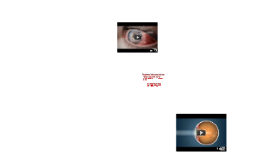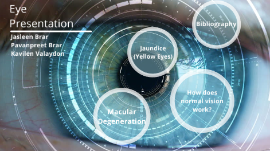Eye - Presentation
Transcript: OUR BUILT IN OPTICAL DEVICE THE EYE Elisabeth Kanczula The Eye OVERVIEW The eye is a complex organ found in animals. About 70% of sensory receptors are found in the eye. Its primary function is to detect light, and send signals up the optic nerve to be processed by the brain. The brain then forms this information into the image we see. ANATOMY OF THE EYE ANATOMY The human eye has multiple key components that work together to help form an image. The components of the eye that are most commonly talked about are the cornea, iris, lens, retina, pupil, vitreous gel, and optic nerve Cornea The Cornea Around the eye is a completely transparent, protective layer of cells called the cornea. It is about as thick as a credit card As well as being a protective layer, it also holds the eye together. The cornea also refracts the light rays into our eye, ensuring the light rays travel correct into our eye to produce an image. The Iris Iris The iris is a muscle that controls how much light is let into the eye. It dilates and opens when it is in dim light to take in as much light as possible. The iris also contracts in bright light, to prevent too much light from getting into our pupil. Interestingly enough, everyone's iris can be a different colour, depending on how much melanin is in your iris. This melanin is meant to keep the iris opaque and not allow light through. Lens Lens The lens is located between the pupil and the iris, and is formed by a transparent tissue. It focuses light that passes through the vitreous gel in our eye and to our retina, which helps produce a more accurate image. The lens in the human eye is a convex shape, thicker at the middle and smaller at the edges. Retina Retina When light arrives in through the pupil, at first, it is only wavelengths of light. These wavelengths are converted into nerve impulses that the brain can register, which allow us to see detail and the image as we do by our retina. There are two types of cells in the retina, rods and cones. They process different types of light. Rods process black and white, as well as contrast. Cone cells come in three colours, red, blue and green, and allow us to see detail and colour. The Pupil Pupil Looking the centre of the iris, you will see a black circle. This is your pupil! Along with the iris, the pupil controls the light that is let into your eye. The pupil specifically is the hole at which the light enters the eye, allowed it to travel through the lens and eventually to the retina Our pupils appear black because all the light in the tissue of the pupil is absorbed in different ways. Vitreous Humor (Gel) Vitreous Gel The vitreous humor, or vitreous gel, is located behind the lens. As the name suggests, it is a clear gel that fills the eye. Light passes through the vitreous humor before it reaches the retina. The vitreous humor protects the eye and helps it hold its sphere shape. As well, the gel helps ensure the retina is properly connected to the wall of the eye. The Optic Nerve Optic Nerve Once the light is brought into the eye and an image is formed, this image is converted into nerve impulses. These nerve impulses get sent through the optic nerve These nerve impulses are processed by our brain, which produce the image we see of the object we are looking at. How Does the Eye Work, Then? AS AN OPTICAL DEVICE The components of the eye all work together to create the final image we see. FUNCTION DETAILS Light reflects off of an object and is refracted by the cornea. The light then travels into our eye through the pupil. After this, the light rays are further refracted by the lens in our eye. This is so the light is focused on our retina. The image produced by the lens is smaller and inverted, opposed to the image we see. The retina, consisting of rod and cone cells, convert the light into electric impulses. These impulses are then sent up to the brain by the optic nerve. Once the brain receives these signals, the image we see is formed. COMMON VISION ISSUES COMMON VISION ISSUES While our eyes and intricate, complex, well running organs the majority of the time, this does not mean there can't be problems or tricks. Only 35 percent of the population of adults have full functioning vision. Errors can range, such as optical illusions, colorblindness, blurred vision, or near/farsightedness MYOPIA AND HYPEROPIA Hyperopia and Myopia There are many common issues to explain why a persons vision may appear blurry when they look at objects far away or up close. Two common ones are hyperopia, affecting about five to ten percent of the population, and myopia, affecting about thirty percent of the population. Hyperopia Hyperopia is the scientific name given for what we commonly know as farsightedness. Farsightedness occurs when the image produced in the eye is formed behind the retina, as opposed to on the retina. Hyperopia can occur due to the eyeball being too short or the cornea being too flat. HYPEROPIA Myopia MYOPIA Myopia is the medical term for

















